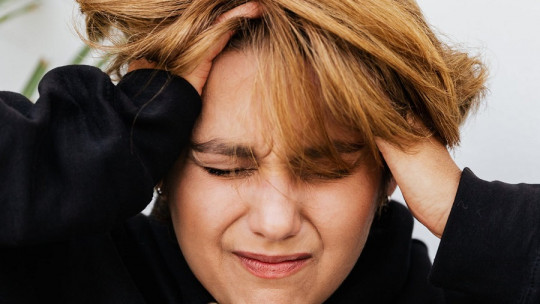The state of mind implies a way of being and being, a pentagram on which the emotion with which the day-to-day experience is faced is based. The most common thing is that it fluctuates based on the situations experienced and the way in which they are interpreted, all within limits that the person feels are tolerable.
Sometimes, however, Some mental disorder may arise that alters the internal balance which we are referring to. In these cases, the affect acquires an overflowing entity, which undermines the quality of life and hinders adaptation to the different contexts in which the person participates.
This type of mental health problems has the particularity of triggering a disparity of challenges (academic, work, social or of another nature), as well as alterations in the structure of the central nervous system, which generate an extraordinary risk of other pathologies arising. during its evolution.
In this case we talk about comorbidities of bipolar disorder , a special situation in which double reflection must be given on the treatment to be followed. This article will address this issue in depth, focusing especially on its clinical expressions.
What is bipolar disorder
Bipolar disorder is a nosological entity included in the category of mood disorders , just like depression. However, its chronic and disabling course tends to differentiate it from the rest of the psychopathologies of such a family, requiring an intensive therapeutic approach and creating a much more gloomy prognosis.
It is characterized by the presence of manic episodes in which the individual appears expansive and irritable and which can alternate with depressive symptoms (in the case of type I); or by hypomanic episodes of lower intensity than the previous ones, but which are interspersed with periods of sadness of enormous clinical relevance (in subtype II).
One of the main difficulties associated with living with this disorder, in whatever forms it may take, is the possibility of suffering from other mental health conditions over time The evidence concerning the issue is clear, highlighting that those who report this problem show a higher risk of satisfying the diagnostic and clinical criteria reserved for many other conditions; or what is the same, of suffering from comorbidities of a diverse nature and consequences.
In this article we will address precisely this question, investigating the most common comorbidities of bipolar disorder according to what we know today.
Bipolar Disorder Comorbidities
Comorbidity is such a common phenomenon in bipolar disorder that it is often considered the norm rather than the exception. Between 50% and 70% of those who suffer from it will manifest it at some point in their lives, shaping the way it is expressed and even treated. “Comorbidity” is understood as the confluence of two or more clinical problems within the area of mental health.
More specifically, this assumption refers to the co-occurrence (in a single moment) of bipolar disorder and another condition different from this one, between which a very profound interaction would become evident (they would transform into something different than what they would be separately. ).
There is evidence that individuals with bipolar disorder and comorbidities report that their mood problem had an early onset and that its evolution is less favorable. At the same time, pharmacological treatment does not generate the same beneficial effect than that which would be observed in people without comorbidity, which results in an evolution “punctuated” by all kinds of “obstacles” that both the patient and his family will have to overcome. One of the most pressing is, without a doubt, the increase in suicidal ideation and behavior.
It is also known that comorbidity increases residual symptoms (subclinical manic/depressive) between episodes, so that some degree of affectation is persistently maintained (absence of states of euthymia), and sometimes it is even observed that the same problem reproduces in other members of the “nuclear family.” And mental disorders among close people are the most relevant risk factor of all those considered in the literature on the foundations of bipolar disorder.
From now on we will delve into the disorders that most commonly coexist with bipolar disorder, as well as the clinical expression associated with this phenomenon.
1. Anxiety disorders
Anxiety disorders are very common in the context of bipolarity, especially in depressive episodes. When the individual is going through a period of acute sadness, it is likely that he or she will coexist with mixed symptoms that includes nervousness and agitation, and even that all the criteria for the diagnosis of an entity such as social phobia or panic attacks are met. Thus, it has been estimated that 30% of these patients suffer from at least one clinical condition of anxiety, and that 20% report two or more.
The most common of all is, without a doubt, social phobia (39%). In such cases, the person manifests great physical hyperarousal when exposed to situations in which others “could evaluate them.” When it is more intense, it may arise at other simpler times, such as eating and drinking in public, or during informal interactions. A high percentage of these patients also anticipate the eventuality that any day they will have to face a feared social event, which becomes a source of incessant worry.
Panic attacks are also common (31%), and are characterized by the sudden emergence of a strong physiological activation (tremors and dizziness, sweating, tachycardia, respiratory acceleration, paresthesias, etc.) that triggers a catastrophic interpretation (“I’m dying” or “I’m going crazy”). “) and in the end it intensifies the original sensation, in an ascending cycle that is extremely aversive for those who enter it. In fact, a high percentage will try to avoid everything that could cause, according to their own ideas, new episodes of this type (thus arising agoraphobia).
The presence of these pathologies in a bipolar subject warrants independent treatment, and should be exhaustively explored in the evaluation sessions.
2. Personality disorders
Personality disorders in cases of bipolarity have been studied according to two possible prisms: either as “base” foundations from which the latter emerges, or as a direct consequence of its effects.
Regardless of the order of appearance, there is evidence that this comorbidity (up to 36% of cases) represents a very relevant complication. Today we know that this group of patients acknowledges having a worse quality of life.
Those who most frequently live with bipolar disorder are those included in cluster B (borderline/narcissistic) and cluster C (obsessive-compulsive). Of all of them, perhaps the one that has reached the greatest consensus in the literature is Borderline Personality Disorder, finding that approximately 45% of those who suffer from it also suffer from bipolar disorder. In this case it is considered that Bipolar disorder and BPD share some emotional reactivity (excessive affective responses depending on the events that trigger them), although with different origins: organic for bipolar disorder and traumatic for borderline.
The joint presence of antisocial disorder and bipolar disorder is linked to a worse course of the latter, especially mediated by increased substance use and increased suicidal ideation (very high by itself in these cases). This comorbidity leads to an emphasis on manic episodes, being a confluence that emphasizes baseline impulsivity and the risk of criminal consequences for one’s actions. Likewise, drug dependence contributes to symptoms such as paranoia, closely linked to all cluster A personality disorders.
Personality disorders finally increase the number of acute episodes that people go through throughout their life cycle, which clouds their general state (even at a cognitive level).
3. Substance use
A very high percentage, which ranges around 30%-50% of subjects with bipolar disorder, abuse at least one drug A detailed analysis indicates that the most used substance is alcohol (33%), followed by marijuana (16%), cocaine/amphetamine (9%), sedatives (8%), heroin/opiates (7%). and other hallucinogens (6%). Such comorbidities have severe effects and can be reproduced in both type I and type II, although it is particularly common in rapid cyclers of the former.
There are suggestive hypotheses that the consumption pattern may correspond to an attempt at self-medication, that is, the regulation of internal states (depression, mania, etc.) through the psychotropic effects of the particular drug that is introduced into the system. organism. The problem, however, is that This use can lead to changes in mood and act as a trigger for manic or depressive episodes Furthermore, there is evidence that stressful events (especially those with social roots), as well as expansiveness, are important risk factors.
Precisely regarding this last issue, regarding possible risk factors for drug use in bipolar disorder, a constellation of personality traits has been described as “potential candidates” (sensation seeking, frustration intolerance, and impulsivity). Anxiety disorders and ADHD also increase the odds, as does being male. It is also known that the prognosis is worse when the addiction precedes the bipolar disorder itself, in contrast to the opposite situation.
In any case, drug use implies a more severe course, a high prevalence of suicidal ideas or behaviors, the emergence of more common episodes with mixed expression (depression/mania), very poor adherence to treatment, a higher number of hospital admissions and a marked tendency to commit crimes (along with the legal consequences that could be foreseen).
4. Obsessive compulsive disorder (OCD)
Obsessive-compulsive disorder (which involves the emergence of obsessive ideas that generate psychological discomfort, followed by some behavior or thought aimed at alleviating it) It is very common in bipolarity, especially during type II depressive episodes (in 75% of patients). These are chronic disorders in both cases, despite the fact that their presentation fluctuates based on the way in which one and the other interact reciprocally. In most subjects, obsession-compulsion is the first to appear, although other times they appear concurrently.
People who suffer from this comorbidity report longer and more intense affective episodes, with an attenuated response to the use of drugs (for both conditions) and poor adherence to them and/or to psychotherapy There is evidence that these patients consume drugs much more frequently (which would be associated with the risk described above), as well as that they live with a notable prevalence of suicidal ideas that require the greatest possible attention (especially during depressive symptoms). ).
The most common obsessions and compulsions in this case are checking (checking that everything is as expected), repetition (washing hands, clapping, etc.) and counting (randomly adding or combining numbers). A high percentage of these patients tend toward constant “reassurance” (asking others to alleviate a persistent worry).
5. Eating disorders
Approximately 6% of people living with bipolar disorder will experience, at some point in their lives, symptoms of an eating disorder. The most common are, without a doubt, bulimia nervosa and/or binge eating disorder ; Bipolarity presenting first in 55.7% of cases. It is usually more common in subtype II, affecting hypomanic and depressive episodes with equal intensity. The relationship between bipolarity and anorexia nervosa seems somewhat less clear.
The studies carried out on this matter are indicative that the concurrent presence of both conditions is associated with a greater severity of bipolar disorder, and apparently with more frequency of depressive episodes and with an early onset (or debut) of the symptoms. An additional important aspect is that increases the risk of suicidal behavior, which is usually notable in the two psychopathologies separately (although feeding off each other on this occasion). What is outlined is more notable, if possible, in the case of women; A greater number of binge eating may occur during menstruation.
Finally, there is consensus regarding the fact that both pathologies precipitate a danger that the subject will abuse drugs or report suffering from any of the disorders included in the nosological category of anxiety. Personality disorders, and especially those of cluster C, could also arise in patients with this complex comorbidity.
6. Attention deficit hyperactivity disorder (ADHD)
A significant percentage of boys and girls with bipolar disorder also suffer from ADHD, which causes hyperactivity and problems maintaining attention for long periods of time. In cases in which ADHD occurs in isolation, approximately half reach adulthood meeting its diagnostic criteria, a percentage that extends further in those who suffer from the comorbidity in question. In this sense, It is estimated that up to 14.7% of men and 5.8% of women with bipolar disorder (adults) have it
These cases of comorbidity imply an earlier onset for bipolar disorder (up to five years earlier than average), shorter symptom-free periods, depressive emphasis, and risk of anxiety (especially panic attacks and social phobia). Alcohol and other drug use may also be present, seriously impairing quality of life and ability to contribute to society through employment. The presence of ADHD in a child with bipolar disorder requires extreme caution with the use of methylphenidate as a therapeutic tool, since stimulants can alter emotional tone.
Finally, some authors have pointed out the connection between this situation and antisocial behavior , which would be expressed in the commission of illegal acts along with potential civil or criminal sanctions. The risk of ADHD is four times higher in boys and girls with bipolar disorder than in their counterparts with depression, especially in subtype I.
7. Autism
Some studies suggest that autism and bipolarity could be two disorders for which a high comorbidity is seen, both in adulthood and in childhood. In fact, it is estimated that up to a quarter of all people with this neurodevelopmental disorder would also have this mood problem. Nevertheless, This fact has been constantly questioned, due to the difficulties of this population in suggesting their subjective experiences with words (when there is no propositional language).
Furthermore, some symptoms may overlap in these two pathologies, which could end up causing confusion for the clinician. Issues such as irritability, excessive talking without a clear purpose, the tendency to be distracted or even rocking happen in both cases; Therefore, special caution must be taken when interpreting them. Insomnia is also often confused with the typical activation or indefatigability of manic episodes.
So, It is possible that the symptoms of bipolarity in autistic people are different from those usually identified in other populations The most recognized are pressure of speech or tachylalia (accelerated rhythm), much more pronounced swaying than usual, unexplained decrease in sleep time (becoming an abrupt change without obvious cause) and impulsivity that frequently leads to aggression.









